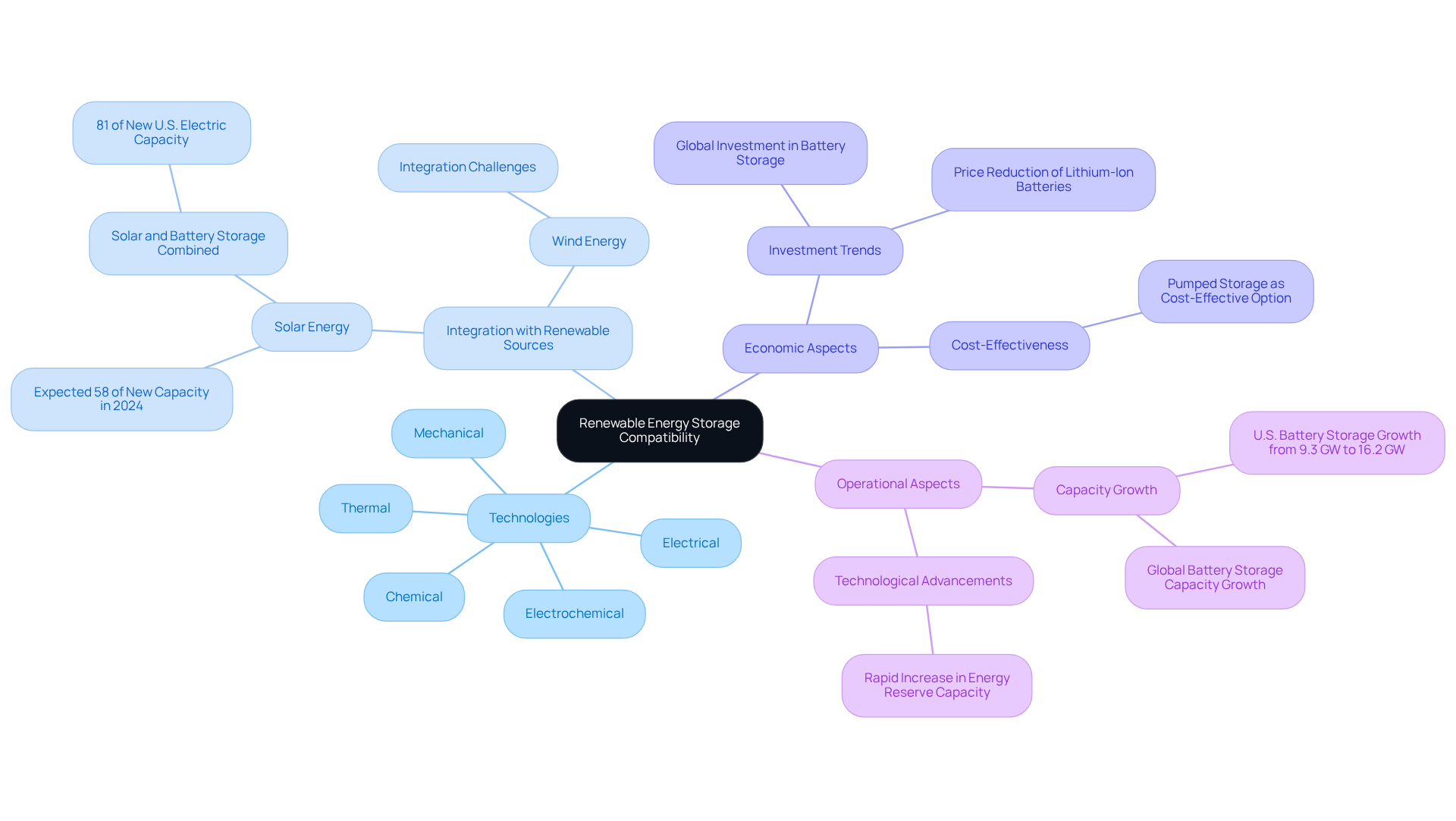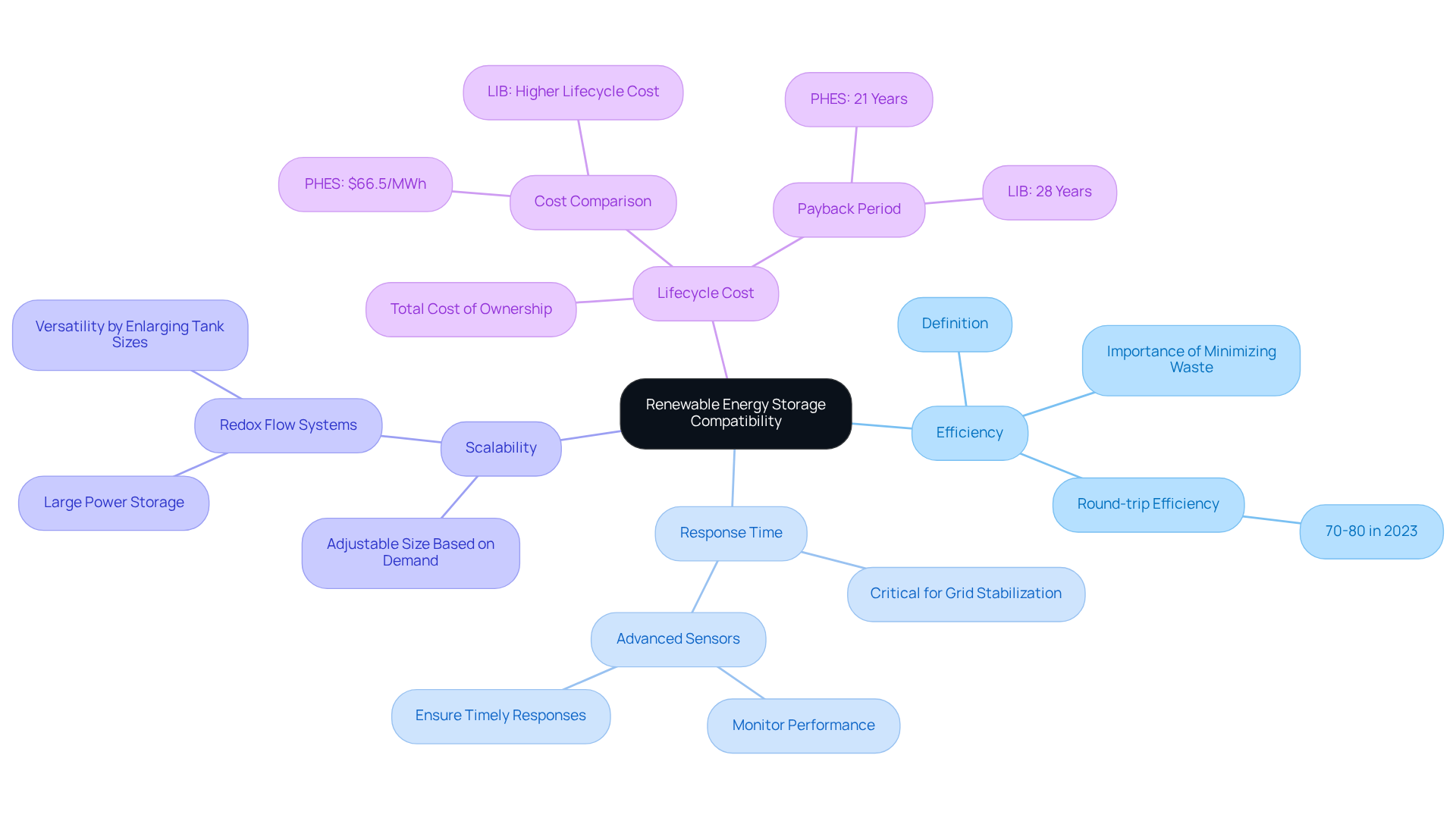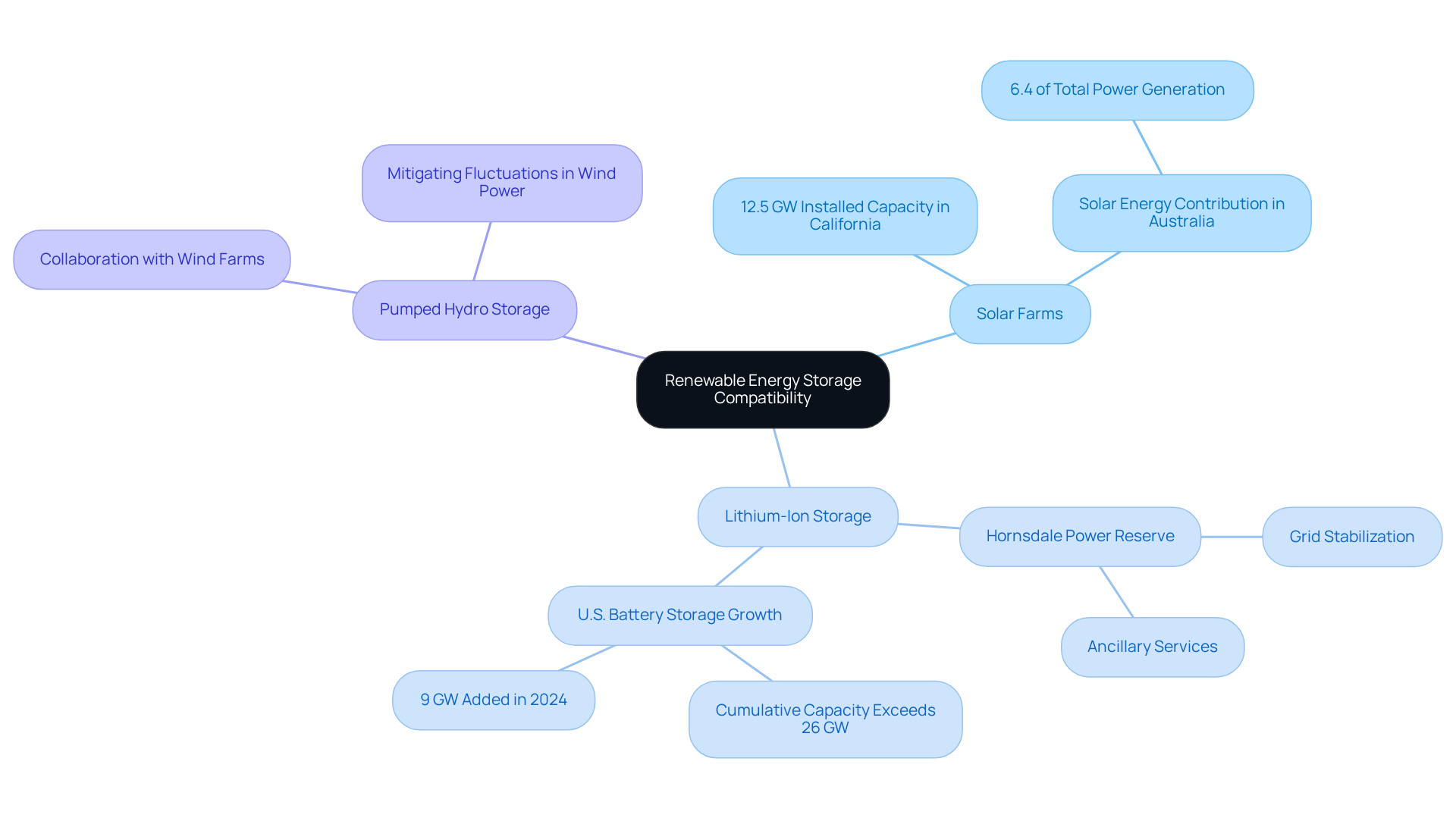Overview
Renewable energy storage compatibility stands as a cornerstone for the efficient integration of diverse energy storage technologies with renewable sources such as solar and wind. This compatibility ensures that energy generated during peak times is effectively stored and utilized during periods of high demand. The significance of this integration is underscored by the rapid growth in energy storage capacity and the advancements in technologies like lithium-ion batteries. These innovations not only enhance system efficiency and reliability but also play a pivotal role in facilitating the transition to a sustainable energy future.
Introduction
The integration of renewable energy sources, such as solar and wind, into the power grid offers remarkable opportunities while presenting complex challenges. With the surging demand for sustainable energy solutions, understanding the compatibility of renewable energy storage systems is crucial for optimizing energy infrastructures and ensuring reliability.
What occurs when the technologies designed to store this energy face compatibility issues? This article explores the significance of storage compatibility, tracing its evolution, identifying key characteristics, and examining real-world applications that highlight its essential role in achieving a cleaner, more efficient energy future.
Define Renewable Energy Storage Compatibility
The renewable energy storage compatibility of sustainable power reserves is essential for the efficient integration of various power retention technologies with green sources like solar and wind. This compatibility ensures that energy produced during peak generation can be stored and utilized during periods of high demand or low production. It encompasses technical, operational, and economic aspects that facilitate seamless interaction among systems—such as accumulators, pumped hydro, and thermal solutions—and renewable power generation technologies.
The rapid increase in energy reserve capacity, which surged from 9.3 GW in 2022 to 16.2 GW in 2023, underscores the growing reliance on these systems to balance supply and demand. Moreover, with solar expected to account for 58% of new capacity in 2024, and both solar and power reserves projected to represent 81% of new U.S. electric-generating capacity, the integration of power reserves becomes increasingly vital.
The U.S. Energy Information Administration reported a remarkable rise in battery capacity in the U.S., escalating from a mere 47 MW in 2010 to 17,380 MW in 2023, illustrating the swift advancements in this technology. Understanding renewable energy storage compatibility is essential for optimizing power systems, enhancing the reliability of sustainable supply, and fostering the transition to a cleaner future.
Additionally, power retention technologies can be categorized into:
- Mechanical
- Electrochemical
- Thermal
- Chemical
- Electrical

Explore the Evolution of Renewable Energy Storage Technologies
The evolution of sustainable power retention technologies has been characterized by pivotal milestones that have reshaped resource management. Initially, power retention relied heavily on mechanical systems, such as pumped hydro—a technique utilized for centuries to balance supply and demand. The introduction of lead-acid accumulators in the 19th century signified a major turning point, facilitating more versatile and accessible storage solutions.
In recent decades, lithium-ion technology has revolutionized the sector, offering enhanced power densities and efficiencies. The cost of lithium-ion power packs has plummeted from over $780 per kilowatt-hour in 2013 to $139 per kilowatt-hour in 2023, representing a staggering 82% reduction. This significant decline has positioned lithium-ion cells as a cornerstone of modern power retention. By 2023, the U.S. power capacity soared to 17,380 MW, a remarkable increase from a mere 47 MW in 2010, underscoring the growing demand for reliable solutions that can adapt to the intermittent nature of sustainable energy sources.
Emerging technologies, such as flow accumulators and thermal retention systems, are currently being developed to further enhance power retention capabilities. These innovations are vital for addressing the challenges posed by renewable energy variability and improving renewable energy storage compatibility, ensuring a stable and efficient power supply. The global battery energy storage system (BESS) market is projected to reach between $120 billion and $150 billion by 2030, highlighting the critical importance of these advancements. The ongoing development of power retention technologies reflects an essential demand for innovative strategies that support the transition to a more sustainable future.

Identify Key Characteristics of Storage Compatibility
Key characteristics of renewable energy storage compatibility include efficiency, response time, scalability, and lifecycle cost. Efficiency is defined as a system's ability to convert and retain power with minimal losses, which is essential for maximizing output. For instance, large-scale electricity retention technologies globally in 2023 demonstrate a round-trip efficiency ranging from 70 to 80 percent, underscoring the importance of selecting systems that minimize waste.
Response time is critical for applications demanding swift power delivery, such as grid stabilization. Energy management systems equipped with advanced sensors can monitor performance and ensure timely responses to fluctuations in demand, thereby enhancing grid reliability. This capability becomes increasingly vital as the integration of renewable sources introduces variability in power supply.
Scalability allows power accumulation systems to be adjusted in size based on demand, facilitating effective resource management. Redox flow systems, for example, can store and produce substantial amounts of power for extended periods without necessitating additional units, thereby offering versatility for various applications simply by enlarging tank sizes.
Lifecycle cost encompasses the total cost of ownership, including installation, maintenance, and operational expenses. The lifecycle expense per megawatt-hour for pumped hydro systems (PHES) is approximately $66.5, significantly lower than that of lithium-ion batteries (LIB), highlighting the financial advantages of specific technologies for energy retention. Furthermore, the payback period for PHES is 21 years, compared to 28 years for LIB, providing additional context regarding the economic benefits.
Understanding these characteristics is essential for stakeholders aiming to select appropriate solutions that ensure renewable energy storage compatibility with their sustainable initiatives and operational goals. As emphasized by industry specialists, the deployment of power retention systems is crucial in accelerating the global transition to sustainable energy sources, illustrating the need for efficient and adaptable technologies. Additionally, forecasts indicate a sevenfold increase in accumulator capacity in Europe by 2030, emphasizing the growing importance of power retention solutions within the sustainable energy framework.

Examine Real-World Applications of Storage Compatibility
The real-world applications of renewable power compatibility are increasingly evident across numerous global projects. Solar farms are progressively integrating accumulator systems to capture surplus power produced during sunny periods, enabling utilization during peak demand hours. A prime example is the Hornsdale Power Reserve in Australia, where a large-scale lithium-ion energy storage installation has effectively stabilized the grid and provided essential ancillary services. This facility has demonstrated the capability of power reserves to enhance grid reliability, leading to a notable decrease in costs and improved resource security. In 2024, California boasted 12.5 GW of installed battery capacity, underscoring the growing significance of such systems. Furthermore, the combination of pumped hydro storage with wind farms illustrates how diverse power sources can collaborate to mitigate fluctuations in wind power production. These applications underscore the critical role of renewable energy storage compatibility in enhancing the reliability and efficiency of renewable energy systems, ultimately paving the way for a more sustainable energy future.

Conclusion
The significance of renewable energy storage compatibility is paramount; it serves as a cornerstone for effectively integrating various energy storage technologies with renewable sources such as solar and wind. This compatibility is crucial for ensuring that energy generated during peak production times can be efficiently stored and utilized during periods of high demand or low generation. Ultimately, this promotes a more stable and sustainable energy landscape.
Key insights throughout the article highlight the evolution of energy storage technologies, transitioning from traditional mechanical systems to modern advancements in lithium-ion batteries and emerging solutions like flow accumulators. Essential characteristics such as efficiency, response time, scalability, and lifecycle cost underscore the necessity for careful consideration when selecting appropriate storage systems. Real-world applications, exemplified by projects like the Hornsdale Power Reserve, illustrate how renewable energy storage compatibility enhances grid reliability and resource security.
As the world increasingly shifts towards sustainable energy solutions, understanding and implementing renewable energy storage compatibility will play a pivotal role in this transition. Stakeholders across various sectors are encouraged to prioritize the adoption of compatible storage systems. Doing so not only supports individual operational goals but also contributes to a collective movement towards a cleaner, more resilient energy future. Embracing these advancements is essential for maximizing the potential of renewable energy sources and ensuring a sustainable environment for generations to come.
Frequently Asked Questions
What is renewable energy storage compatibility?
Renewable energy storage compatibility refers to the efficient integration of various power retention technologies with green energy sources like solar and wind. It ensures that energy produced during peak generation can be stored and used during high demand or low production periods.
Why is renewable energy storage compatibility important?
It is important because it encompasses technical, operational, and economic aspects that facilitate seamless interaction among systems, helping to balance supply and demand. This is crucial for optimizing power systems and enhancing the reliability of sustainable energy supply.
What are the types of power retention technologies?
Power retention technologies can be categorized into mechanical, electrochemical, thermal, chemical, and electrical systems.
How has the capacity for energy reserves changed recently?
The capacity for energy reserves surged from 9.3 GW in 2022 to 16.2 GW in 2023, indicating a growing reliance on these systems for balancing supply and demand.
What role is solar energy expected to play in the near future?
Solar energy is expected to account for 58% of new capacity in 2024, with both solar and power reserves projected to represent 81% of new U.S. electric-generating capacity.
How has battery capacity in the U.S. changed over the years?
Battery capacity in the U.S. has increased dramatically from 47 MW in 2010 to 17,380 MW in 2023, showcasing rapid advancements in energy storage technology.
What is the significance of understanding renewable energy storage compatibility?
Understanding renewable energy storage compatibility is essential for optimizing power systems, enhancing the reliability of sustainable energy supply, and supporting the transition to a cleaner energy future.
List of Sources
- Define Renewable Energy Storage Compatibility
- Topic: Energy storage worldwide (https://statista.com/topics/4632/energy-storage)
- Renewable Energy Systems and Infrastructure | Energy Storage (https://ren21.net/gsr-2024/modules/energy_systems_infrastructure/02_energy_storage)
- Clean Energy Storage Facts | ACP (https://cleanpower.org/facts/clean-energy-storage)
- Solar and battery storage to make up 81% of new U.S. electric-generating capacity in 2024 - U.S. Energy Information Administration (EIA) (https://eia.gov/todayinenergy/detail.php?id=64126)
- Energy storage for electricity generation - U.S. Energy Information Administration (EIA) (https://eia.gov/energyexplained/electricity/energy-storage-for-electricity-generation.php)
- Explore the Evolution of Renewable Energy Storage Technologies
- Clean Energy Storage Facts | ACP (https://cleanpower.org/facts/clean-energy-storage)
- Enabling renewable energy with battery energy storage systems (https://mckinsey.com/industries/automotive-and-assembly/our-insights/enabling-renewable-energy-with-battery-energy-storage-systems)
- Empowering the Future: The Most Inspirational Quotes About Battery Energy Storage (https://eszoneo.com/info-detail/empowering-the-future-the-most-inspirational-quotes-about-battery-energy-storage)
- Facts about Battery Energy Storage (https://enelgreenpower.com/learning-hub/renewable-energies/storage/faq-storage-usa-canada)
- Global Energy Storage Market Records Biggest Jump Yet | BloombergNEF (https://about.bnef.com/insights/clean-energy/global-energy-storage-market-records-biggest-jump-yet)
- Identify Key Characteristics of Storage Compatibility
- A snapshot of the stats from the 2024 Renewable Report — RatedPower (https://ratedpower.com/blog/statistics-renewable-report-2024)
- Understanding the Efficiency of Energy Storage Systems - Key Factors and Performance Metrics - Qmerit (https://qmerit.com/blog/understanding-the-efficiency-of-energy-storage-systems-key-factors-and-performance-metrics)
- Clean Energy Storage Facts | ACP (https://cleanpower.org/facts/clean-energy-storage)
- Large-scale energy storage technologies efficiency| Statista (https://statista.com/statistics/1434317/global-round-trip-efficiency-energy-storage-technologies)
- Life cycle environmental and economic impacts of various energy storage systems: eco-efficiency analysis and potential for sustainable deployments (https://academic.oup.com/ieam/advance-article/doi/10.1093/inteam/vjaf035/8046021?searchresult=1)
- Examine Real-World Applications of Storage Compatibility
- Topic: Energy storage worldwide (https://statista.com/topics/4632/energy-storage)
- U.S. Battery Storage Hits a New Record Growth in 2024 (https://carboncredits.com/u-s-battery-storage-hits-a-new-record-growth-in-2024)
- A snapshot of the stats from the 2024 Renewable Report — RatedPower (https://ratedpower.com/blog/statistics-renewable-report-2024)
- What Statistics Indicate the Growth of Battery Storage and Solar Power Integration? → Question (https://sustainability-directory.com/question/what-statistics-indicate-the-growth-of-battery-storage-and-solar-power-integration)
- U.S. battery storage capacity expected to nearly double in 2024 - U.S. Energy Information Administration (EIA) (https://eia.gov/todayinenergy/detail.php?id=61202)




